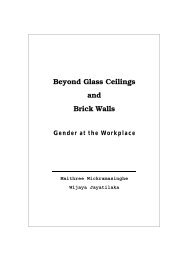SETP No. 14 The Economic Value of Incremental Employment in the ...
SETP No. 14 The Economic Value of Incremental Employment in the ...
SETP No. 14 The Economic Value of Incremental Employment in the ...
Create successful ePaper yourself
Turn your PDF publications into a flip-book with our unique Google optimized e-Paper software.
8. It is shown <strong>in</strong> <strong>the</strong> forth area <strong>of</strong> <strong>in</strong>vestigation that <strong>the</strong> macro economic effects <strong>of</strong><br />
labour-based earthwork excavation are greater than those <strong>of</strong> equipment-based<br />
construction. A case can <strong>the</strong>refore be made for a f<strong>in</strong>ancial premium for <strong>the</strong><br />
substitution <strong>of</strong> labour for equipment. In addition, if we view <strong>the</strong> import component<br />
<strong>of</strong> locally manufactured earth mov<strong>in</strong>g equipment as ‘lost’ expenditure (lost to <strong>the</strong><br />
country) <strong>the</strong>n labour can compete f<strong>in</strong>ancially with equipment under a much<br />
greater range <strong>of</strong> physical conditions and wages.<br />
9. <strong>The</strong>se results are sensitive to <strong>the</strong> import component <strong>of</strong> locally manufactured<br />
construction equipment. From this it follows that <strong>the</strong> factor that most effects <strong>the</strong><br />
f<strong>in</strong>ancial premium is <strong>the</strong> degree <strong>of</strong> capital amortisation. Compar<strong>in</strong>g <strong>the</strong> macro<br />
economic effect <strong>of</strong> labour aga<strong>in</strong>st new earth mov<strong>in</strong>g equipment with a 71% import<br />
component <strong>in</strong>dicates that a labour premium <strong>of</strong> over 50% is justified. However this<br />
premium falls to 4% once <strong>the</strong> capital cost is fully amortised. Similarly compar<strong>in</strong>g<br />
labour to a mach<strong>in</strong>e with 48% import component calls for a 32% labour premium<br />
when <strong>the</strong> mach<strong>in</strong>e is new but aga<strong>in</strong> only 4% when fully amortised.<br />
10. A comparison <strong>of</strong> <strong>the</strong> direct cost <strong>of</strong> earthwork excavation <strong>in</strong>dicates that labourbased<br />
methods may be f<strong>in</strong>ancially viable even without macroeconomic premiums.<br />
In <strong>the</strong> Cape Town area this happens only at low wages and easy ground<br />
conditions. <strong>The</strong> competitiveness <strong>of</strong> labour-based earthworks excavation decl<strong>in</strong>es<br />
rapidly as wages <strong>in</strong>crease and/or ground conditions deteriorate. It is suspected<br />
that higher equipment costs outside <strong>of</strong> urban areas will result <strong>in</strong> greater f<strong>in</strong>ancial<br />
viability for labour-based earthwork <strong>in</strong> rural and remote rural areas. In addition, a<br />
programme approach will improve labour productivity and make it more<br />
competitive.<br />
11. In general <strong>the</strong> report draws mixed conclusions about <strong>the</strong> f<strong>in</strong>ancial viability <strong>of</strong><br />
labour-based methods <strong>of</strong> road rehabilitation. <strong>The</strong> macroeconomic advantages <strong>of</strong><br />
labour-based methods are compell<strong>in</strong>g when we use fully imported equipment and<br />
rema<strong>in</strong>s so even for locally produced equipment with an import component. When<br />
<strong>the</strong> capital cost <strong>of</strong> <strong>the</strong> equipment is fully amortised <strong>the</strong>n <strong>the</strong> macroeconomic<br />
advantage <strong>of</strong> labour-based methods becomes marg<strong>in</strong>al.<br />
12. <strong>The</strong> overwhelm<strong>in</strong>g case that must be made for us<strong>in</strong>g labour-based methods is <strong>the</strong><br />
contribution it will make to economic empowerment. Roads, dams and o<strong>the</strong>r<br />
<strong>in</strong>frastructure are good for <strong>the</strong> regional economy and will allow it to grow. Us<strong>in</strong>g<br />
labour-based methods will generate jobs and provide <strong>in</strong>comes fur<strong>the</strong>r promot<strong>in</strong>g<br />
<strong>the</strong> regional economy. Involv<strong>in</strong>g local communities will help <strong>in</strong> capacity build<strong>in</strong>g.<br />
Us<strong>in</strong>g small and emergent contractors will generate susta<strong>in</strong>able <strong>in</strong>comes and<br />
opportunities.<br />
13. It is beyond <strong>the</strong> scope <strong>of</strong> this report to attempt to quantify <strong>the</strong> effects <strong>of</strong> labourbased<br />
methods on economic empowerment. In a similar ve<strong>in</strong> we cannot quantify<br />
<strong>the</strong> cost <strong>of</strong> economically marg<strong>in</strong>alis<strong>in</strong>g poor rural people by us<strong>in</strong>g equipmentbased<br />
methods. Yet, even without be<strong>in</strong>g able to quantify <strong>the</strong>se effects, we believe<br />
that <strong>the</strong>re is an overwhelm<strong>in</strong>g case for labour-based methods. <strong>No</strong>t only will it help<br />
<strong>the</strong> poor but it will also contribute to <strong>the</strong> generation <strong>of</strong> susta<strong>in</strong>ed economic growth<br />
and empowerment.<br />
xiii
















